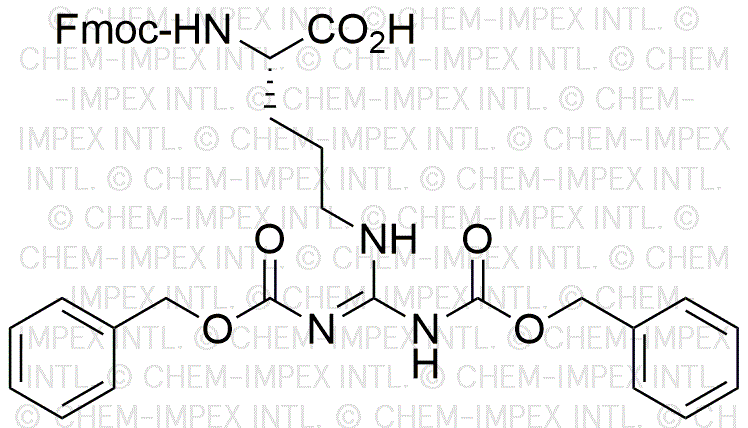Fmoc-Arg(Z)2-OH (asymmetric) is widely utilized in research focused on:
- Peptide Synthesis: This compound is commonly used as a building block in solid-phase peptide synthesis, allowing researchers to create complex peptides for various applications in biochemistry and pharmacology.
- Drug Development: Its role in modifying peptide structures makes it valuable in drug discovery, particularly for developing peptide-based therapeutics that can target specific biological pathways.
- Bioconjugation: The chemical is employed in bioconjugation techniques, where it helps attach peptides to other molecules, enhancing the functionality of drugs or diagnostic agents.
- Protein Engineering: By incorporating this compound into proteins, researchers can study protein folding, stability, and interactions, which are crucial for understanding biological processes.
- Research in Cancer Therapeutics: Its application in synthesizing peptide analogs is particularly relevant in cancer research, where modified peptides can be designed to inhibit tumor growth or enhance immune responses.
General Information
Properties
Safety and Regulations
Applications
Fmoc-Arg(Z)2-OH (asymmetric) is widely utilized in research focused on:
- Peptide Synthesis: This compound is commonly used as a building block in solid-phase peptide synthesis, allowing researchers to create complex peptides for various applications in biochemistry and pharmacology.
- Drug Development: Its role in modifying peptide structures makes it valuable in drug discovery, particularly for developing peptide-based therapeutics that can target specific biological pathways.
- Bioconjugation: The chemical is employed in bioconjugation techniques, where it helps attach peptides to other molecules, enhancing the functionality of drugs or diagnostic agents.
- Protein Engineering: By incorporating this compound into proteins, researchers can study protein folding, stability, and interactions, which are crucial for understanding biological processes.
- Research in Cancer Therapeutics: Its application in synthesizing peptide analogs is particularly relevant in cancer research, where modified peptides can be designed to inhibit tumor growth or enhance immune responses.
Documents
Safety Data Sheets (SDS)
The SDS provides comprehensive safety information on handling, storage, and disposal of the product.
Product Specification (PS)
The PS provides a comprehensive breakdown of the product’s properties, including chemical composition, physical state, purity, and storage requirements. It also details acceptable quality ranges and the product's intended applications.
Certificates of Analysis (COA)
Search for Certificates of Analysis (COA) by entering the products Lot Number. Lot and Batch Numbers can be found on a product’s label following the words ‘Lot’ or ‘Batch’.
Número de catálogo
Número de lote/lote
Certificates Of Origin (COO)
This COO confirms the country where the product was manufactured, and also details the materials and components used in it and whether it is derived from natural, synthetic, or other specific sources. This certificate may be required for customs, trade, and regulatory compliance.
Número de catálogo
Número de lote/lote
Safety Data Sheets (SDS)
The SDS provides comprehensive safety information on handling, storage, and disposal of the product.
DownloadProduct Specification (PS)
The PS provides a comprehensive breakdown of the product’s properties, including chemical composition, physical state, purity, and storage requirements. It also details acceptable quality ranges and the product's intended applications.
DownloadCertificates of Analysis (COA)
Search for Certificates of Analysis (COA) by entering the products Lot Number. Lot and Batch Numbers can be found on a product’s label following the words ‘Lot’ or ‘Batch’.
Número de catálogo
Número de lote/lote
Certificates Of Origin (COO)
This COO confirms the country where the product was manufactured, and also details the materials and components used in it and whether it is derived from natural, synthetic, or other specific sources. This certificate may be required for customs, trade, and regulatory compliance.


